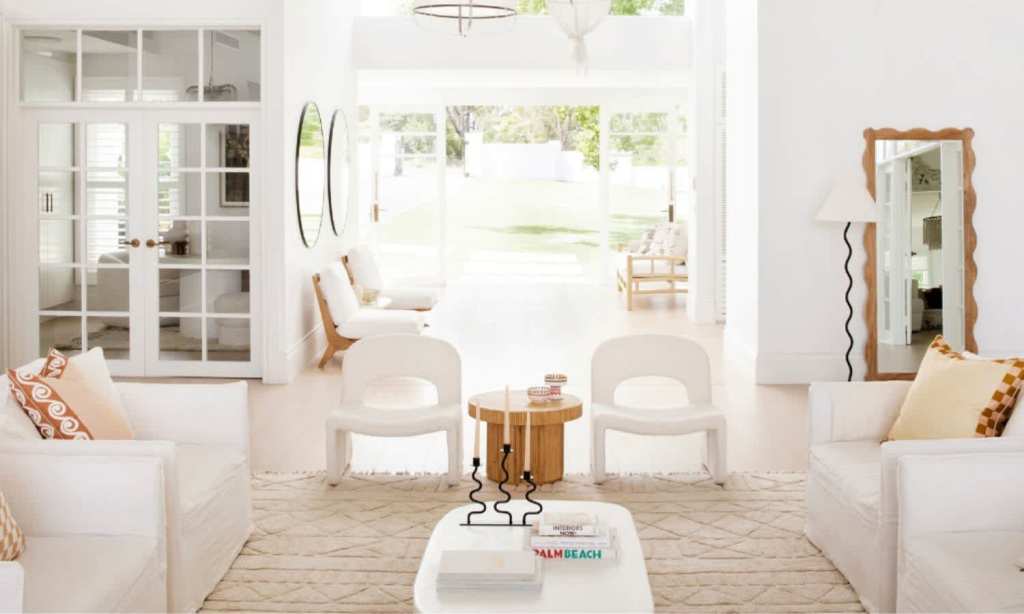I’d never really thought much about the placement of rugs at home until my interior stylist friend was visiting my apartment one day and pointed out that moving my lounge room rug could really change my space.
I had an open plan lounge room-slash-dining room at the time, and my friend explained that the rug in my lounge room area could be used to help separate the two spaces. She also explained that instead of the rug placed all the way in front of my couch, it should ideally be positioned one-third underneath, with two-thirds of it in front.
At the time, I moved the rug so it sat somewhat underneath the couch, and she was right — it did entirely change the space. It made it look more like a ‘styled’ lounge room rather than just an area with a few pieces of furniture and homewares thrown in.
That was a few years ago, and to this day, I can never look at a lounge room with a rug placed all the way in front of the couch without fighting the urge to tuck it partially under.
I’m sharing all this because a) how good is that simple rug styling hack?, and b) I decided to ask that same interior stylist friend — Camilla Ingall, founder of a Sydney-based interior design and property styling company — for more tips on how to place rugs in your home.
“Rugs add warmth, texture and personality,” says Ingall. “Often, a lounge room area feels a little ‘naked’ without a rug as it can feel like a group of independent pieces rather than presenting as a thoughtful and deliberate design. Similarly, in the dining room, rugs frame the dining table and chairs to form an area that’s separate and can serve functionally too for pets and kids — opting for a jute or sisal rug that’s durable and low maintenance for all those crumbs.”

“Lastly, in your hallway — adding a hall runner can make a bland, minimal entryway feel warm, inviting and character-filled.”
Ahead, Ingall shares her other tips for choosing and placing rugs in your home.
Always Consider Proportion When Choosing a Rug
The first and most important consideration when buying a rug is proportion, says Ingall. “I can tell you, firsthand, this is where all my clients tend to go wrong and, unfortunately, end up exchanging their purchase,” she says.
“When sourcing your rug, aesthetic and function are one thing, however, ensuring the dimensions of your rug not only suits the space but fits well and doesn’t look either underdone or overpowering, is key,” she says.
For example, and as a rule of thumb, for a lounge room where your sofa length is standard 3-seater sizing, you would ideally opt for a rug that is rectangular and sits at 3m x 2m. This shape would run along the length of the sofa, providing a nice edge around the sofa, while the 2m width would sit one-third under the sofa and two-thirds in front, allowing a proportional coffee table to sit on top.
Use a Rug to Frame Your Bed
“Rugs in bedrooms are great for not only warmth under foot, but to frame the bed,” says Ingall. “Framing the bed with a rug finishes off the room; it creates a focal point in the space and adds layer, texture and comfort.”

Ideally, you want the rug to sit one-half to three-quarters of the way down the bed. For a queen size bed, for example, the most suitable rug size then would be a 2.3 x 1.6m, a standard size in rugs, explains Ingall. The size for a queen would also account for 350mm on either side of the bed, ideal for chilly winter mornings when you can hop out of bed and step onto a warm, woven rug.
Ensure Your Dining Room Rug Is Large Enough
As for rugs in the dining room, Ingall says it’s important to find a rug that’s large enough to sit under both the table and all the chairs.
“It’s never ideal to be sitting at the dining table and to push back out of your chair and scuff the edging of the rug,” she says. “This is not only uncomfortable and annoying, but it will create a curl in the edging of the rug over time.”
Let Some Floor Show
Finally, when choosing and positioning a rug, you want to ensure there’s still enough floor space — tiling, carpet or timber flooring, for example — that frames the area around the rug, says Ingall. Displaying floor space around the rug makes the space feel more open and spacious, as opposed to having the rug take up too much of the space and then making it feel cramped.
All this said, Ingall notes that choosing a rug and where to position it is always case-by-case, as well as dependent on the client’s furnishings. And again, rug placement will always vary depending on the room — whether in it’s the dining room, bedroom, hallway or kitchen.
Scroll down to see three of our favourite rugs to shop right now.
Rug Culture Natural Fibre Barker Rug (270 x 180cm), $305.99
Mocka Lexa Floor Rug (medium), $99.95

Miss Amara Leilani Ivory Cream Textured Rug, starting at $275

Read more stories from The Latch and subscribe to our email newsletter.








